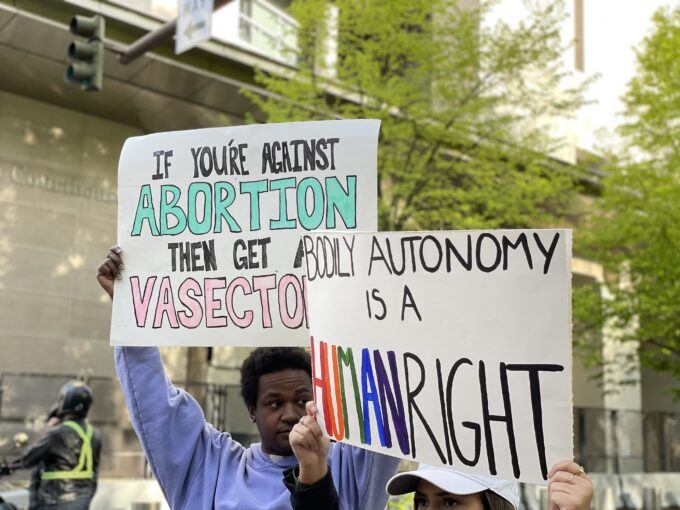Letter From Crimea: Bloody Sunday 1962
Brings Down the Soviet Union
This is the tenth in a series about a journey, by train and bicycle, across Russia to Crimea shortly before the war began.

Striking workers in Novocherkassk, in southern Russia, killed by Soviet police and troops on June 2, 1962. The rally was among the first public uprisings against the government of the Soviet Union, caused by a cut in wages and price hikes for meat and butter. Photo: Matthew Stevenson.
After my visit in Novocherkassk (in southern Russia) to the Ataman Palace, I ate lunch in an open air restaurant—it cost about $6 and was the best meal of the trip—and set off on my bicycle to explore the contours of what was called Bloody Saturday in the history of the Soviet Union. It was the 1962 massacre of twenty-four civilians (plus the wounding of many others) who were protesting price increases for meat and butter, plus wage cuts at the Novocherkassk Electric Locomotive Plant (NEVZ), where many of the protesters were employed.
I knew that there was a stone marker for those killed in the massacre, and that in 2008 President Vladimir Putin, on a visit to Novocherkassk, laid flowers next to the memorial. (If he were required to lay flowers beside every site in Ukraine where the Russian government has massacred twenty-four civilians, he would have to leave government and become a full-time florist.) But it took me a while to find the small stone marker, which turned out to be about ten meters from where I had locked my bicycle outside the palace.
Bloody Saturday Divides the Soviet Union
Prior to leaving for Russia, I had bought a copy of Samuel H. Brown’s Bloody Saturday in the Soviet Union: Novocherkassk, 1962, the first definitive western account of the massacre, published by Stanford University Press in 2001.
I only finished the book when I got home, but I took with me copies of several maps from the book showing the route of the protest marchers from the NEVZ locomotive plant to the Party headquarters, which in 1962 was located in the Ataman Palace on the main city square.
Initially in Moscow, as the strike was forming, it was feared that the Cossacks were in revolt. One Khrushchev official on the scene kept saying, as quoted by Brown: “The religious sectarians [and/or the Cossacks] have instigated the mutiny.”
Brown’s thesis is summoned up in his last sentence, which reads: “As Bloody Sunday [the 1905 revolution in St. Petersburg] had radically transformed the way masses of people perceived the tsarist regime, similarly, if less immediately, Bloody Saturday [Novocherkassk in 1962] helped to destroy the legitimacy of the Soviet regime.”
All Quiet on the Tuzlov Bridge
From the Ataman Palace, I headed north on the bicycle from downtown Novocherkassk toward the Tuzlov Bridge, which is between the locomotive factory (a huge plant about four miles outside the city) and the old Party headquarters.
Because I had seen my fill of factories in Volgograd, I stopped my bicycle on a headland above the river, from which I could see the path taken on June 2, 1962, when about 5-10,000 unhappy factory workers decided to air their grievances by marching from the factory to the Party headquarters in the city center and then to the nearby police station.
Aware that a crisis was brewing, both the local and Moscow governments had manned the barricades, in some cases with tanks, to keep the protests from “getting out of hand”.
On the bridge over the Tuzlov River, tanks were parked to thwart the marchers, but the regional army commander decided not to shoot at the demonstrators, who pressed on to the city center, where some gave speeches and others threw rocks and other missiles. There had been a KGB plan to fire water cannons on the protestors, but in the moment the hoses remained closed.
In front of the Party headquarters—around the square in front of the Ataman Palace—demonstrators voiced their unhappiness with the regimes large and small. Prices were up, wages were down, working conditions were unsafe, and the utopian future looked bleak. Their chanted slogan was: “Bread, Meat, and a Pay Raise.” (In 1917, the Bolsheviks chanted “Peace, Land, and Bread.”)
In response, as happened at the Haymarket in Chicago (in 1886) or at Homestead Steel (in 1892), troops, police, or state security personnel opened fire on the demonstrators (think too of Kent State for the confusion around the shootings) and killed twenty-four citizens, whose black and white pictures are in display in an annex of the Ataman Palace.
In later deconstructions of the shootings, many came to believe that the army troops positioned in front of the palace shot only into the air, and that the fatal volleys came from KGB and security personnel positioned on the roof.
To this day, no one is quite sure who gave the fatal orders and who fired the shots that killed twenty-four and wounded dozens more.
The Great Soviet Cover-Up
As General Secretary of the Communist Party and head of the Politburo in Moscow, Nikita Khrushchev (who by the way grew up in the Donbas) took the protests to be an existential threat to his one-party rule, and once the scene of the massacre was cleared (and hushed up), he ordered that some one hundred and fourteen so-called provocateurs be put on trial for inciting the riot, for which, in some cases, the sentence was death.
Most of the demonstrators (even if they were just caught up in the marches) were convicted. All got harsh prison terms, and eight protesters were executed.
Even more barbaric was the decision to scatter the burials of the dead in anonymous graves and to deny the grieving families any official mourning. The governments in Moscow and locally also did their best to suppress any news of the massacre, denying that it had even happened. (Over the years some Russian and foreign journalists, including my friend George Feifer, reported on aspects of the massacre.)
Solzhenitsyn Breaks the Story
Not until the fall of the Soviet Union in 1991, some thirty years after the massacre, did the facts of the cases become public, although in the 1970s to his credit Aleksandr Solzhenitsyn pieced together the narrative and published an account in his Gulag Archipelago.
As he was writing his history Solzhenitsyn even traveled to Novocherkassk and interviewed survivors. Samuel Brown writes: “Solzhenitsyn was the first writer to describe accurately the terrain on which the events occurred, and the first to get the chronology right.”
Solzhenitsyn believed the violence and cover up of Novocherkassk was a watershed moment in the Soviet Union. He wrote: “We can say without exaggeration that this was a turning point in the history of modern Russia.” As quoted by Brown, he called it: “a cry from the soul of a people who could no longer live as they had lived,” but Solzhenitsyn’s Gulag history did not appear in Russia until 1990.
General Shaposhnikov: An Unlikely Hero
If there was a hero in the shameful story, it was General Matvei Kuzmich Shaposhnikov, who was the commander of the North Caucasus garrison and Novocherkassk, thus responsible for insuring domestic tranquility.
He did two things that were remarkable: first, he refused to open fire on the protestors as they came across the Tuzlov Bridge (he said in effect, “I don’t see before me a foe we should attack with our tanks…”). After all, these were workers—in a worker state, and Shaposhnikov had worked in mines and factories before joining the army and serving with distinction as a tank commander in World War II.
Second, once he figured out that Khrushchev’s government was doing its best to suppress news of the revolt and massacre, Shaposhnikov wrote an open letter and circulated it to a number of important Russian writers (including Konstantin Simonov, who wrote Days and Nights about Stalingrad), urging them to investigate how the Communist Party had devoured its own in Novocherkassk. For his efforts Shaposhnikov was put on trial, cashiered from the military, and made a non-person.
Not until the government of Mikhail Gorbachev came to power in the 1980s was Shaposhnikov exonerated. He received a judicial ruling that read: “Only under the conditions of perestroika, the democratization of all dimensions of life of Soviet society, has it become possible to acknowledge that you are innocent.”
At a time when it appears that the Russian army is a hostage to Putin’s fortune, it is comforting to know that somewhere in the military ranks there are the equivalents of General Shaposhnikov—prepared to act on their conscience.
Next: On the train to Crimea and the Tatar city of Bakhchysaray. Earlier installments can be found here.M





